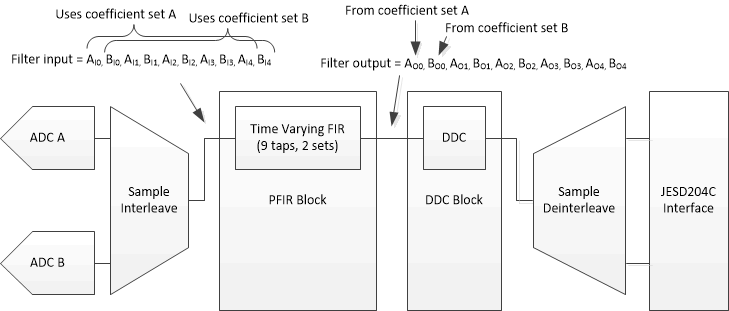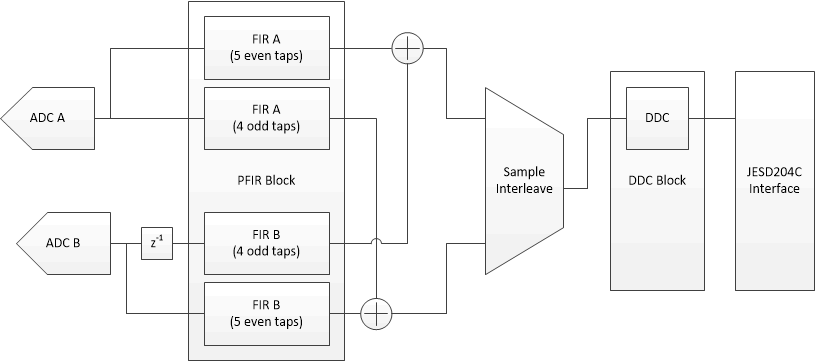ZHCSOJ3A march 2023 – may 2023 ADC12DJ5200SE
PRODUCTION DATA
- 1
- 1 特性
- 2 应用
- 3 说明
- 4 Revision History
- 5 Pin Configuration and Functions
-
6 Specifications
- 6.1 Absolute Maximum Ratings
- 6.2 ESD Ratings
- 6.3 Recommended Operating Conditions
- 6.4 Thermal Information
- 6.5 Electrical Characteristics: DC Specifications
- 6.6 Electrical Characteristics: Power Consumption
- 6.7 Electrical Characteristics: AC Specifications (Dual-Channel Mode)
- 6.8 Electrical Characteristics: AC Specifications (Single-Channel Mode)
- 6.9 Timing Requirements
- 6.10 Switching Characteristics
- 6.11 Typical Characteristics
-
7 Detailed Description
- 7.1 Overview
- 7.2 Functional Block Diagram
- 7.3
Feature Description
- 7.3.1 Device Comparison
- 7.3.2 Analog Inputs
- 7.3.3 ADC Core
- 7.3.4 Temperature Monitoring Diode
- 7.3.5 Timestamp
- 7.3.6 Clocking
- 7.3.7 Programmable FIR Filter (PFIR)
- 7.3.8 Digital Down Converters (DDC)
- 7.3.9
JESD204C Interface
- 7.3.9.1 Transport Layer
- 7.3.9.2 Scrambler
- 7.3.9.3 Link Layer
- 7.3.9.4 8B/10B Link Layer
- 7.3.9.5
64B/66B Link Layer
- 7.3.9.5.1 64B/66B Encoding
- 7.3.9.5.2 Multiblocks, Extended Multiblocks and the Local Extended Multiblock Clock (LEMC)
- 7.3.9.5.3 Block, Multiblock and Extended Multiblock Alignment using Sync Header
- 7.3.9.5.4 Initial Lane Alignment
- 7.3.9.5.5 Block, Multiblock and Extended Multiblock Alignment Monitoring
- 7.3.9.6 Physical Layer
- 7.3.9.7 JESD204C Enable
- 7.3.9.8 Multi-Device Synchronization and Deterministic Latency
- 7.3.9.9 Operation in Subclass 0 Systems
- 7.3.10 Alarm Monitoring
- 7.4
Device Functional Modes
- 7.4.1 Dual-Channel Mode
- 7.4.2 Single-Channel Mode (DES Mode)
- 7.4.3 Dual-Input Single-Channel Mode (DUAL DES Mode)
- 7.4.4 JESD204C Modes
- 7.4.5 Power-Down Modes
- 7.4.6 Test Modes
- 7.4.7 Calibration Modes and Trimming
- 7.4.8 Offset Calibration
- 7.4.9 Trimming
- 7.5 Programming
- 7.6 SPI Register Map
- 8 Application Information Disclaimer
- 9 Device and Documentation Support
- 10Mechanical, Packaging, and Orderable Information
7.3.7.3 Time Varying Filter
When the ADC is operating in dual-input single channel mode (based on the JMODE setting and SINGLE_INPUT setting) then the PFIR filter can be set in time varying filter mode. This mode enables a time varying filter with two coefficient sets that are alternated between on a per sample basis. Each coefficient set consists of 9 coefficients that can be independently set. The center tap of the filter has a resolution of 18 bits and the LSB has a weight of 2-16. The non-center taps have a resolution of 12-bits with programmable LSB weight of 2-10, 2-11, 2-12, 2-13, 2-14, 2-15 or 2-16. All non-center taps have the same LSB weight. The block diagram for time varying filter mode is shown in Figure 7-6 and an alternate block diagram is given in Figure 7-7 which shows the equivalent filter in an I/Q correction-type topology.
 Figure 7-6 Time Varying Filter PFIR Block Diagram
Figure 7-6 Time Varying Filter PFIR Block Diagram Figure 7-7 Alternate I/Q Correction-Type Filter Block Diagram
Figure 7-7 Alternate I/Q Correction-Type Filter Block Diagram